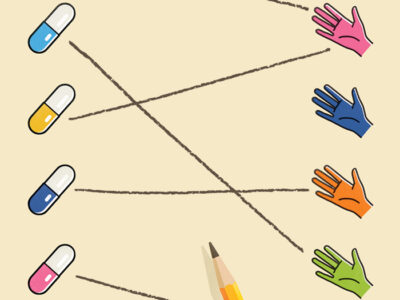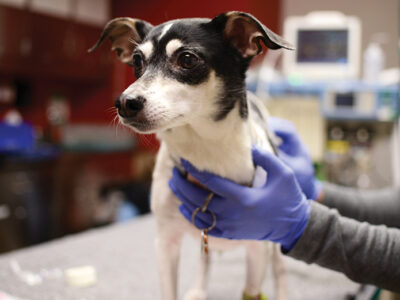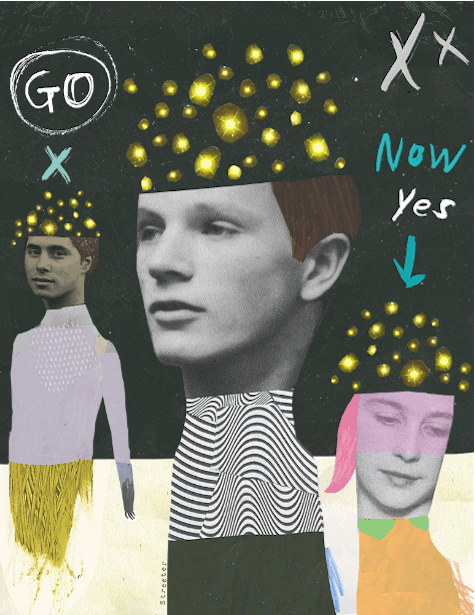
Penn Medicine’s Frances E. Jensen is a leader in studying how the brain develops and what that means for learning, behavior, and the treatment of disease at different ages. For her recent book plumbing the mysteries of the teenage brain, she drew on the latest neuroscience findings—and the experiment going on in her own home.
BY JOANN GRECO | Illustration by Katherine Streeter
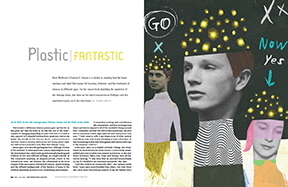
As far back as her own teenage years, Frances Jensen had the brain on her mind.
“Did it make a difference where a person grew up? How he or she grew up? Was the brain at all like the rest of the body—capable of changing depending on what went into it or what it was exposed to? I enjoyed turning these questions over in my head,” she recalls in The Teenage Brain: A Neuroscientist’s Survival Guide to Raising Adolescents and Young Adults, written with science journalist Amy Ellis Nutt (Harper, 2015). [Excerpt: “Be Prepared”]
Jensen goes on to describe getting her first “inklings of some of the answers” to these questions—and a compelling lesson in the brain’s plasticity—while working with mentally handicapped children in two very different settings. As a high schooler at the Greenwich Academy, an all-girls private school in the Connecticut town, one summer she volunteered at the local chapter of the Association of Retarded Citizens. Ample funding and the affluent backgrounds of the families of many of the children attending ensured a rich, stimulating environment.
“I remember working with one little boy who was autistic, and how exciting it was when I got him to respond to all of the wonderful things around him. I remember another kid with Down’s syndrome—we were able to teach him double-digit addition and subtraction,” she says. “I had come in with a pre-disposition of what mental retardation was—and it was shocking to learn otherwise. It was fascinating to discover what games and lessons and trips to the museum could do.”
A few years later, as a student at Smith College, she volunteered at the Belchertown State School, a notoriously understaffed and overcrowded state mental institution. In the children’s dormitory there, toys, trips, and therapy were all distinctly lacking. “It was clear that an enriched environment on top of a disability can maximize potential,” she says.
“Like the children at Greenwich’s ARC,” she explains in the book, “some were more disabled than others, but even those who were more functioning seemed to lag far behind their peers at ARC … It was pure and simple: the brains of the ARC children were being stimulated and encouraged, and the brains of the Belchertown children were not.”
Jensen’s nascent interest in the way the brain develops would send her on a quest for knowledge that has over time garnered her numerous awards and research grants—and, in 2012, brought her to Penn and her current position as professor and chair of the Department of Neurology at the Perelman School of Medicine. Along the way, she’s established herself as a sought-after expert on neurological issues, both as related to her own main research focus—the physiological mechanisms of epilepsy, the disorder’s secondary effects on the plasticity of synapses, and the development of treatments that can slow its progression and even possibly prevent occurrences by translating basic scientific findings to therapeutic intervention—and more generally in the field.
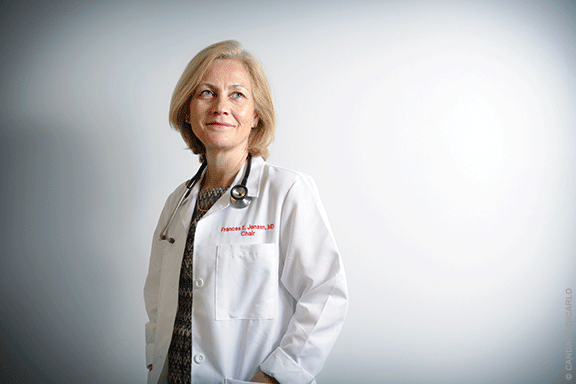
“Frances has become one of the best ambassadors for the clinical neurosciences,” says Marc Dichter, emeritus professor of neurology at Penn. Dichter has known Jensen since her days as a medical resident at Harvard University, and their paths have crossed repeatedly during the three decades since. “She’s very cognizant that the problems of the brain have become a major social issue and that our job is to make sure that the public is aware of all of the research that’s going on out there.”
Neurology is “everywhere,” Jensen says. “As the population ages and survivorship for below-the-neck illnesses increases, we’re seeing its impact.” As examples, she cites what’s commonly referred to as ‘chemo brain’—the foggy thinking and memory problems that can often come with cancer treatments—as well as cognitive problems that arise after pre-mature births and, of course, the epidemic of dementia: all issues that would never have surfaced without improvements in medical care and general longevity.
“There are a thousand ways the brain can go wrong,” she says. “But we have to realize that there are probably some shared mechanisms [among those ways].” Why then, she asks, do we persist in separately studying, say, stroke, multiple sclerosis, and epilepsy? “Brain research needs to be ‘de-siloed,’” she says.
Jensen has presented the case for aggregating all things mind, brain, and nervous system to the Congressional Neuroscience Caucus, and she serves on the National Institutes of Health’s scientific advisory panel for the BRAIN (Brain Research Through Advancing Innovative Neurotechnologies) Initiative. The $300 million effort—launched by President Obama in 2013—involves universities, foundations, and federal agencies and aims to find ways to prevent, treat, and cure a host of cognitive and neural disorders ranging from Alzheimer’s and Parkinson’s, to post-traumatic stress injury and epilepsy. Diseases of the brain will be “considered a dominant issue for public health moving forward,” she says.
Brain plasticity was still a relatively new concept when it grabbed hold of Jensen, now 58, back in high school. Although William James had used the term as early as 1890—writing in The Principles of Psychology that “[o]rganic matter, especially nervous tissue, seems endowed with a very extraordinary degree of plasticity”—it wasn’t until the 1960s and early 1970s that a spate of new research showed that the brain could be molded by experience or training.
In 1947, Canadian neuropsychologist Donald O. Hebb allowed lab rats to run free in his home (enlivened by his very human children) and saw that they subsequently performed better at figuring out mazes than caged ones. The research that grew out of his trials—such as studies conducted by Mark Rosenzweig in the late 1950s at the University of California, Berkeley, and psychologist William Greenough’s experiments at the University of Illinois during the 1970s—furthered the theory we know so well today: stimulation and enrichment build strong young minds. Cue the Baby Einstein and Baby Mozart DVDs.
And then, by around age four or six or eight, you’re done, right?
“I’m here to tell you that that’s not the case,” Jensen declared to the two dozen or so Society Hill neighbors who had gathered at Headhouse Books to hear her talk about The Teenage Brain last spring. “You have one brain—and in those seven or eight years, you’re setting it up for life?” she all but scoffs. “Well, actually the brain doesn’t fully mature until the mid-twenties, maybe even as late as the early thirties.”
During just the last decade or so, she explains, an explosion in imaging techniques along with the ability to run tests on actual human tissue has allowed scientists to dig deep to reveal the brain’s inner workings. Take a technology like optogenetics, for example, in which certain cells are genetically modified to become light sensitive, allowing scientists to study specific neural pathways.
“Before, it was sort of the blind man and the elephant,” Jensen says. “We were looking at little pieces of the brain, but we never really saw how the whole thing was working, nor how it was connected. We have the ability now to image the whole brain and see how different areas are co-activated. We’re noticing there are patterns that might be similar in different diseases or change with age.”
With special reference to teenagers, another new technology—functional magnetic resonance imaging (fMRI)—allowed scientists at the NIH to map the brain’s activation over the first 21 years of life. They discovered that the connectivity of the brain develops slowly, moving from back to front, where our so-called executive functions—judgment, insight, planning, risk assessment, and impulse control—are housed.
The picture provides a physiological explanation for the psychological tendencies that most parents of teenagers recognize all too well: with those executive functions lagging in development, the teenaged brain is primed to seek rewards and ignore risks. “During fMRI experiments, when adult subjects make an error, their cingulate cortex [which can act as a behavioral monitor] lights up as if to say, ‘Oh boy, I’d better make sure not to do that again.’ This part of the brain is still being wired in teenagers, making it more difficult for them, even when they recognize a mistake, to learn from it,” Jensen writes. “Experimental studies in rats show that … these areas [the brain’s pleasure center where dopamine is released in anticipation of a reward] are more active and more responsive in the adolescent than the adult. Without a fully [developed] frontal lobe to provide inhibition, this can drive risk-taking behavior higher.”
Besides promoting better understanding of teen behavior, in her introduction Jensen expresses her hope to “offer practical advice so that parents can help their teenagers, too.” A big part of that, she emphasizes, comes from the research (“real data from real science journals”) that the book synthesizes, which is likely to be more persuasive than some version of “because I said so!” “[T]he teen generation is one that holds information in great esteem,” she counsels. “So when you talk to teens, you owe it to them to have actual data.”
The New York Times called The Teenage Brain a “charming” translation of “good science … into good parenting.” It probably helped that Jensen’s expertise extended to the parenting part as well as the science. A decade or so ago she was a recently divorced single mom raising two teenaged boys, and that experience—along with stories from the families Jensen has encountered in her many public talks on the subject—grounds the wealth of scientific data in lived detail.
(It also offers some light at the end of the tunnel to parents of current teenagers: Jensen’s son Andrew, who at 15 turned up one day with his hair dyed jet-black—with plans to add red streaks—majored in quantum physics at Wesleyan and is now in a joint MD-PhD program at Penn, and Will, who made a careless turn on his way to school and totaled the family car soon after getting his driver’s license, has since graduated from Harvard and is now working as a business consultant in New York.)
Jensen devotes the first third of The Teenage Brain to explaining how the brain functions and develops, then delves more specifically into its relation to the teenage fondness for risk taking, cigarettes, alcohol, drugs, and sleeping into the afternoon. She ends by looking at the perils, like addiction (which is basically another form of learning, she says), stress, mental illness, sports injuries, and criminal activity, that can befall some of them.
The teenage brain, she explains, has been a neglected area of study until very recently. Research dollars for neurology more typically go toward understanding the very young brain and how it does, or does not, learn, or toward studying diseases of the older brain, like Alzheimer’s. At the same time, she writes, we—scientists, parents and most likely teens themselves—settled comfortably on a set of assumptions about this strange period between childhood and adulthood. The script went something like this: teens are moody and rebellious because they have raging hormones; it’s okay if teens experiment with drink and drugs because they’re resilient; and they pretty much reach their intellectual peak around puberty.
Instead, writes Jensen, “their brains are both more powerful and more vulnerable than at virtually any other time in their lives.” Adolescents enjoy faster learning curves than adults due to better plasticity—making these years a “time to identify strengths and invest in emerging talents,” she adds, noting that the IQs of one-third of teenagers actually increase during this period. As for addiction to drugs and booze, teenagers not only succumb faster than adults—they “have much greater difficulty ridding themselves of the habit.”
Because most of this magazine’s readers are no longer teenagers themselves, this might be a good time for a refresher course on how the brain works and how learning occurs.
The outermost layer of the brain, the cerebral cortex, is what we term the “gray matter.” It consists of 100 billion neurons, the cells responsible for thought, motion, perception, and body function controls. Neurons respond to stimuli—a heady smell, a new word, a thunderous crash—by sending an electrical signal that passes through the cell and into the synapse, a space that’s two-millionths of an inch wide. This signal is released as a chemical message which then locks onto the neuron on the other side. And so on and so on and so on: the firing and wiring that’s the essence of the brain’s working. A neuron “can have up to ten thousand synapses and can send a thousand electrical impulses every second,” writes Jensen. Synapses “come in two flavors,” she continues. “[O]nes that excite, or turn on, the next neuron, and ones that inhibit, or turn off, the next neuron.” Significantly, the young brain has more excitatory synapses than inhibitory ones.
A few specific and key processes happen to the brain during the teenaged years. These include arborization, wheregray matter grows as connections increase and branch out; myelination, where myelin, the white matter that enables speedier neural transmissions, is developed; andpruning, where the brain fine-tunes and eliminates earlier connections deemed no longer useful. An amusing scene in this summer’s animated hit, Inside Out, illustrated that last process when vacuum-bearing authorities swept through an 11-year-old’s brain and removed all of her piano lessons, leaving only “Chopsticks” and “Heart and Soul.”
Jensen has relied on this new body of evidence two times as an amicus curiae in Supreme Court cases concerning the punishment of convicted juveniles, which she describes in a chapter on “Crime and Punishment” late in the book. The gist: because their brains are still developing, young adults under the age of 18 have not yet mastered rational decision making or impulse control, and are more vulnerable to external influences. At the same time, since they are not yet fully formed, the chance for rehabilitation is strong. She was the only neurologist among 17 experts who filed an amicus brief for Graham v. Florida (2010)concerningthe unconstitutionality of sentencing juveniles convicted of non-homicide offenses to life imprisonment without parole.
Two years after the Court ruled that such sentencing was indeed unjustified, Jensen and others wrote in support of extending that ruling to all juvenile offenders, even those who had murdered. Writing for the majority in a 5-4 decision on two consolidated cases, Jackson v. Hobbs andMiller v. Alabama, Justice Elena Kagan cited the neurological evidence presented in these two cases, along with a previous one, Roper v. Simmons (2005)which found against the execution of minors. Life terms were not outlawed, but the Court noted that judges and juries must consider mitigating factors such as the defendant’s age, environment, and crime on a case-by-case basis.
Jensen’s advocacy, experience, and presentation skills—offered not only in these cases, but during numerous radio and TV interviews and a TED Med presentation—has made her the go-to person when it comes to discussing the uniqueness of teens.
The book has cemented that reputation. It appeared briefly on best-seller lists and even earned a shout-out from comedy director Judd Apatow in a recent “what’s on your nightstand” interview in The New York Times. The popularity of the book hasn’t generated any push-back from fellow scientists, though, Jensen says.
“I didn’t do an official book tour or anything,” she says with a laugh. “I have a day job.” But she was “shocked,” she adds, at the book’s success. “I’m a complete unknown in terms of the public,” she says. “It’s the fact that it’s real science put into context for people to understand. I frankly think that the lesson there is that we should probably be doing more of this. That’s one message I give to my colleagues when I talk about the book. Pulling information together is clearly such a valuable thing to do.”
Jensen’s own adolescence, growing up in the rarefied air of Greenwich and regularly traveling to Europe to visit relatives, was one of affluence and opportunity. Her English mother and half-English/half-Danish father had moved to the US when her father accepted a residency at Columbia University after finishing medical school in London.
Jensen says she learned to “take risks and look for opportunity” from her dad’s intrepidness. If that lesson ever threatened to veer into the wrong kind of risk-taking, it sounds like her mother—who was trained to serve in the British secret service and had debriefed prisoners of war after World War II—was there to keep young Frances on her toes.
“I’d phone her with some tale about being at someone’s house,” Jensen recalls, sitting in her office on the third floor of the Hospital of the University of Pennsylvania a few weeks after the bookstore appearance. “She’d start firing off endless questions to try and figure out if I was where I said I was. I couldn’t get away with anything. I thought I was smart—I wasn’t that smart.”
With such strong role models, Jensen found her path relatively early. The rigorous math and science instruction she received at Greenwich Academy helped, too. (“I don’t think I realized how unusual that [curriculum] was for the time,” she says.) In the book, she relates an anecdote about dissecting a pig fetus in ninth-grade biology class and the varied reactions of her classmates. “It was one of those defining moments,” she writes. “The scientists had separated from those destined to be the writers, lawyers, and businesspeople of the future.”
“I’m a visual-spatial person,” she says, glancing out the window at the stone turrets and blossoming trees of the main campus. “I love three-dimensional thinking, which is helpful in seeing connections.” As a child she enjoyed drawing so much that she briefly thought about going to art school. “I liked the accuracy involved in copying an image and creating a portrait sketch,” she says. “I loved capturing these complicated, wrinkled faces and how they were proportioned.”
Instead, she decided to focus on the complicated, wrinkled, and sectioned object inside our skulls. As an undergraduate at Smith College, she created her own major, neuropsychology, by combining aspects of biology with psychology. Doing so, she says, “taught me something I’ve lived by ever since—the value of being pro-active, and the idea of ‘nothing ventured, nothing gained.’ If I had sat and waited for the course list and not moved out of the box …”
Jensen spent her junior year abroad taking courses at University College London, which was a “huge place for the history of neuroscience,” she says. “Many of the founding fathers—J.Z. Young, Patrick Wall, John Eccles—came out of there.” Back home as a senior, she found herself working with Nico Spinelli, a professor at the University of Massachusetts-Amherst who was conducting experiments exploring the plasticity of the visual cortex.
For her honor’s thesis, she and Spinelli co-wrote an article, published in the journal Science, which reported that when kittens learned to associate certain “safe” stimuli with a corresponding visual stimulus—of vertical or horizontal lines—they benefited from an increase in the number of neurons in those parts of their visual cortex. The conclusion: young brains are shaped by experience.
“My interest in the teenage brain is really an extension of my overall interest in how the brain matures,” she says now. “Plasticity is tremendously appealing to me because it says we have more control over our makeup than previously thought. It tells us that you don’t become who you are very early, and just stay there.”
Much of Jensen’s career has involved seeking to understand the chemistry and origins of this process. “Specifically with epilepsy and other brain diseases and disabilities associated with young children, I’m looking for a way to develop a therapy that recapitulates that heightened strength of experiential learning,” she says.
One in 26 people will develop epilepsy at some point in their lifetime, she notes, and around 5 percent of all children experience at least one seizure. Half of epilepsy sufferers also have cognitive and psychiatric problems, and while there are more than 25 drugs on the market (15 of which have been introduced in the last decade), they only suppress seizures rather than prevent them.
What we do know about the cause of an epileptic seizure is that it is a result of too much excitation between cells. “And that’s why the vast majority of incidents begin in childhood,” Jensen says. “That’s when by nature the brain is prone to a lot more excitation than inhibition.”
Jensen’s work in this area is some of the “most exciting in the field,” according to Dichter. “She’s been able to demonstrate very specific changes in some cells and circuits which make the brain more excitable and therefore more likely to develop epilepsy,” he says. “She didn’t prove the causal relationship, but she said, ‘This could be what’s going on,’ and she was able to use some drugs that blocked that change and also blocked the development of epilepsy. It’s one of the first demonstrations that we can intervene with drugs that are available, though they’re not approved for this use.”
Jensen summarizes her work as “figuring out what is different about the developing brain and whether different approaches to treatment are required at different points.”
That’s starting to happen in the field, in general, she says. “We’re [creating] a pipeline for device and drug development [and] looking for pathways of disease as we step through from early, mid, late, and chronic stages in a disease. We’re starting to ascribe specific signaling to each therapeutic target that you would treat differently. We’re getting at disease modifications, not just taking care of the symptoms. We’re getting at the root cause and we’re looking to reverse a disease or prevent it from progressing.”
The proactivity is new, she adds. “It’s not your grandmother’s neurology, anymore. It’s not this somewhat sleepy group of bookish-type people describing symptoms and the causes; it’s becoming much more interventional. This next 10 years will be a very, very active time in our field.”
A recent research focus has been on exploring connections between epilepsy and autism. “Why do 40 percent of kids with autism have epilepsy? What’s going on?” Jensen asks. “Well, we have all these synaptic proteins that can be changed by epileptic seizures. A lot of them are associated with genes that are well-known autism targets, they’re all in the same pathways that epilepsy activates.”
In fact, Jensen calls epilepsy a “spectrum” disorder, just like autism. “Seizures are just the tip of the iceberg,” she says, with everything from attention deficits to sudden unexplained death falling along the spectrum. Yet, epilepsy medicines mainly treat seizures, and they do so by promoting inhibition. “But [in child sufferers] there aren’t many of these receptors to start with,” she points out. “We’re using adult drugs and they don’t work. We’ve started to look at new treatments based on what we know about brain development, we’re going for very age-specific targets.”
Her mantra, she adds, is “no more hand-me-down drugs for the developing brain.”
After Smith College and her experience working with Spinelli at UMass, Jensen headed to Cornell University Medical College. She kept up her Boston ties by working during the summers as a research associate for Children’s Hospital of Boston, and upon graduating from Cornell in 1983, she and her then-husband scored a couples match to do their residencies at Harvard. While still a resident, she won a grant from the NIH and has been funded by the agency ever since. In 2007, the NIH gave her its Pioneer award to support her research on how epileptic seizures in early life can co-opt normal plasticity mechanisms and lead to cognitive deficits and learning disabilities.
“We fund only about 14 percent of the grant applications we get, so for someone like Frances to receive consistent funding means the science coming out of her lab is of extremely high quality,” observes Walter J. Koroshetz, director of NIH’s National Institute of Neurological Disorders and Stroke. When he came to NIH in 2007, Koroshetz says he unsuccessfully tried to lure Jensen, whom he’s known since the early 1980s, to join him. “She’s a person who builds very well,” he says. “She can take a place that has good resources and take it to another level.”
Those qualities are being put to good use at Penn’s Department of Neurology, the nation’s oldest, where Jensen has been professor and chair since 2012. “Being a department chair was not on my bucket list,” Jensen says. “But the more I met with people and learned about the position, the more I realized it was something I’d love to do.” On the cusp of accepting a nomination to run for president of the field’s biggest organization, the 40,000-member Society for Neuroscience (SFN), she chose Penn.
These days, she teaches and sees patients, as well as mentoring the research assistants and grad students who work in her lab, conducting studies on her areas of interest, and readying them for presentation before groups such asthe 3,000-member American Epilepsy Society, which Jensen headed from 2012-2013 and which convenes in Philadelphia this December.
Jensen also spends a lot of time thinking about strategies for growing the department. Penn’s ranking in neurology & neurosurgery in U.S. News & World Report’s Best Hospitals list is #13 in the nation for 2015-16, patient ratings have increased, and there has been significant growth in the faculty. “It feels good to be part of these changes and innovations,” she says.
And there’s more to come. Jensen has encouraged her lab to pursue efforts related to translational neuroscience, which seeks the rapid translation of clinical discoveries into usable therapies and devices. “My strategy as a department chair is to encourage people to talk across silos,” she says. “Translation is the idea that you might be able to go from one silo to the other. Short cut! Take advantage of the work that was done in one and apply it to another.”
She’s set up four “translational centers of excellence.” The idea is to have groups of people from different disciplines talking about, for now, auto-immune neurology, neuro-engineering, neuro-genetics, and outcomes research, with more in the planning. “There are many things we could have picked, but we started with the areas that, in order to get Penn in a better leadership position, needed to be brought up,” Jensen explains. One recent collaboration, between her department and Penn Engineering, involves the creation of new types of electrodes that are flexible and can be implanted in the brain to control seizures. “Penn is an ideal institution to do this,” Jensen says. “We’re all on one campus. Collaborations are going to happen much more rapidly here.”
Jensen relishes these attempts to bring neuroscience into the greater conversation. “There needs to be better awareness that neuroscience is highly applicable to your daily life,” she says. “We’re just at the crest of this happening.”
The timing is right for her, too. “It’s funny, but in medicine—unlike in other professions—you’re just coming into your own in your fifties and sixties.”
JoAnn Greco is a frequent contributor to the Gazette.
EXCERPT
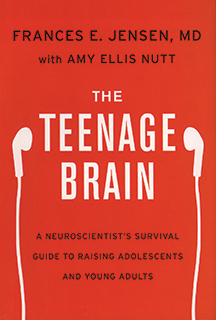
“Be Prepared”
First, count to ten. It became a kind of mantra for me when I was raising my sons. But it means more than just taking a deep breath. Let me explain. In leadership courses I’ve taken for my professional career, one theme that is always emphasized is the Boy Scouts’ motto, “Be prepared.” I learned in these seminars that the average time an American businessperson spends preparing for a meeting is about two minutes. We probably spend more time just scheduling those meetings than actually thinking about what we’re going to say or do in them. I don’t mean the big presentations. I mean the one-on-one encounters, which we too often step into cavalierly without taking much time for reflection beforehand …
[I]t’s these more personal, more direct interactions that often play a pivotal role in the success of the organization. Similarly, the impression you give others in these encounters can affect the direction your career takes; this is why it’s so important to plan ahead, at least for more than a few minutes, and think about how the other person will react during one of these meetings. In your mind, go through what you want to say, step-by-step, and imagine the range of responses. Now imagine that the other person is your teenage son or daughter. Being prepared for both positive and negative responses will help guide you as you consider your options about what to say or do next. If you appear hotheaded or mentally disorganized, you lose credibility, whether it’s with a colleague, an employee, or your teenager.
For parents or teachers, or anyone who has a caring relationship with a teenager, reading this book will arm you with facts—and with fortitude. Changing the behavior of your teen is partly up to you, so you have to come up with a plan of action and a style of action that fits your household and your kids, as well as your needs and wants. Remember, you are the adult, and if your child is under eighteen, you also are legally responsible for that “child.” Certainly the courts will hold you responsible for your child, and, by extension, for the environment you provide for him or her. So take the lead, take control, and try to think for your teenage sons and daughters until their own brains are ready to take over the job. The most important part of the human brain—the place where actions are weighed, situations judged, and decisions made—is right behind the forehead, in the frontal lobes. This is the last part of the brain to develop, and that is why you need to be your teens’ frontal lobes until their brains are fully wired and hooked up and ready to go on their own.
From The Teenage Brain: A Neuroscientist’s Survival Guide to Raising Adolescents and Young Adults, by Frances E. Jensen with Amy Ellis Nutt.


